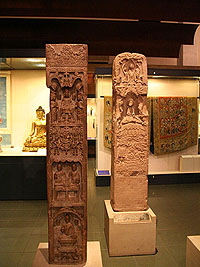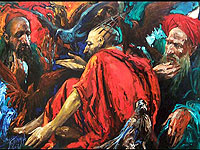 |
|
Uzbekistan - Fine Arts |
|||
|
The most ancient monuments of art on the territory of Uzbekistan are the rock paintings of animals and hunting scenes of the Paleolithic period in the Zarautsoi settlement. Some rock drawings of animals in Khojakent and Bustanlik belong to the Neolithic period. The antique period saw the rise of art culture in various spheres of fine and applied arts (4th century B.C. - 4th century A.D.). The sculpture used to be made of clay, fashioned in gypsum, but rarely of stone. The clay statues with colored paintings, discovered in Khalchayon settlement (1st century B.C.), vary in their depiction of human figure - grandees, deities, warriors, musicians, and children. The sculpture of the southern regions of Uzbekistan experienced changes with Buddhism expanding in the area. A stone frieze from Airytom (2nd century) with depictions of heavenly musicians, and other antique figures serves as an example for the aforesaid. The gypsum statues from Buddhist sanctuary at Dalvamntepa (2nd century) represent authentic images of followers of Buddhism mat dates back to the Bactrian and Kushan reign. Free style and beautiful paintings are inherent in the writings on the wall in the south of Uzbekistan. The style of art depicted in ancient monuments is said to have also reflected in the applied ait of antique Uzbekistan. In some stone as well as silver- and gold-embroidered items of the Bactrian period one may observe the influence of the Hellenic-Roman period upon art. The ancient art as a whole depicts original features pertaining to all over Central Asia, but the remains of items discovered in the southern regions distinctly reveal Hellenic, and later on - Indian roots. The painting style that dates back to early medieval period (especially the Samarkand style) is refined, solemn and full of dynamics and various movements of the characters portrayed. The paintings portray rich Samarkand fabrics. The 14th and 15th centuries saw the renaissance of fine arts. Paintings of landscapes have been preserved to days in the Samarkand mausoleums. Some palaces of Amir Temur used to be decorated with pictorial panels with portraits of the ruler himself, his wives, sons, associates, as well as rich and feast scenery depicted on them.
The works by the Samarkand school of painting - close to Herat school are: illustrations to the list of astronomical tractate by Al-Sufi, the miniature with Ulughbek depicted on it, miniatures on Alisher Navoi's "Khamsa", and others. One could notice romantic exposition in their style. During 16th and 17th centuries significant success was achieved in the manuscript art and bookbinding. Both Samarkand and Bukhara saw the rise of the Central Asian schools of miniatures. At the second half of the 19th century and early 20th century, fine am began gradually to permeate the lives of Uzbek people, at first in the form of commercial printed products, and later - in the form of magazines and books. Direct transition towards fine arts has been observed vis-a-vis breach of centuries-long traditions that stood for obligatory styles, conditioned with certain religious beliefs. The early 20th century saw the development of poster and graphic arts. Schools of art in Tashkent, Samarkand, and other cities are said to have played a significant role in training of the experts in the field. Alongside the initial schools, other art institutions were established in the area.
|

